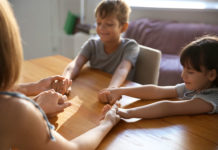Have you ever been teaching a class or had a group where everything was going smoothly and all of a sudden that child showed up and everything fell apart? You know what I’m talking about. The frenzied chaotic child who breezes into your group and he or she brings the outside chaos inside. All of a sudden bedlam and pandemonium reign.
Children of divorce live lives marked by chaos and disorder. There are so many things about the divorce that can cause chaos, it is impossible to list them all, but they can include:
- Loss of the non-custodial parent
- Moving to a new home
- Going to a new school
- Financial difficulties
- Lack of rules and structure at home
- Increased responsibility
- Loss of rituals and routines
- Arguing parents
- Differing expectations
- Lack of planning, step-families
- Lack of consistency
Children, who live in chaos and their brains are wired to be chaotic as a result, bring that chaos along with them wherever they go. In order to effectively minister to these children of divorce, a children’s ministry leader needs to understand the chaos that marks their world and work hard at helping the child understand what is expected of him or her.
The other day I got a call from a person who was at a spring break camp. At her church she is a DC4K (DivorceCare for Kids) leader. She said out of all these kids she noticed one girl who just couldn’t sit still. She was moving all day long and all the time. And she was getting in trouble a lot. My friend looked at the little girl’s chart and saw that this little girl, whose parents are divorced, lives in a homeless shelter. Her life is filled with chaos from early in the morning until late at night.
Being a DC4K leader my friend knows there needs to be some accommodations made for this child. Because this child’s brain thrives on chaos, the child can’t just start sitting still and paying attention all of a sudden.
There are a number of factors that can lead to this chaos. The first factor is that they are generally living with an exhausted and stressed single parent. This tends to lead to chaos in their daily lives. Secondly, many of these kids are bounced back and forth between two homes, latchkey, grandparents and other makeshift child-care arrangements on a daily and weekly basis
Imagine at 6, 9 or 12 years of age having to keep track of:
- Where you are supposed to be
- Who is picking you up from where and when
- Keeping track of items you will need at so-and-so’s house
- Making sure your school work is done for the next day when you have spent after school time in three different places
- Keeping track of that message that Mom had for Dad
- Making sure that message gets delivered
- And more and more and more!
What you can do:
Routine and Structure: Take into consideration the importance of a consistent routine each week. Develop your regular routine and then post it on the wall in several places. Encourage the kids to keep track of the routine by checking it occasionally throughout the class. The schedule becomes a routine they can count on to happen. Put another way, the routine becomes a structure that is dependable.
For seriously chaotic kids, I encourage you to make up a smaller individual version of your schedule, laminate it and give it the child to carry around in their pocket or a chain around the neck.
Rituals: Kids in chaos need to be able to connect with the leaders through rituals. After several weeks of a dependable ritual such as a handshake, fist bump, etc. the ritual will help calm the chaotic feelings.
A ritual can feel calming under the skin. Rituals soothe the lower levels of the brain. A goodbye ritual at the end of a class gives the kids closure on the session. Many kids don’t get closure in relationships as people come and go in their lives after a divorce, so being able to depend upon a goodbye ritual can also send them out into the world a little calmer and more in control.
Rooms: Disorganization on the outside can create or lend to disorganization and chaos in the mind. Supplies need to be organized in an orderly fashion. Decorations need to look organized with not too many bright colors, shapes and graphics.
De-stressing Activities: Kids whose lives are full of chaos need ways to de-stress. These kids need to cross lateral and cross midline activities. This can be accomplished by moving to praise music or children’s songs. Or you can have the entire group stand and stretch and breathe deeply.
Change the mindset: Leaders, teachers and volunteers need to change their mindset about some of the children whose lives are filled with chaos.
When my friend who was observing the spring break camp approached the person in charge about this little girl she was told, “1,500 other kids have figured it out. She can too.” More than likely this little girl can’t figure out what she is supposed to be doing because she is doing what is normal for her in her life style. She needs someone to come alongside her and assist her.
While we can’t rewire the brains in chaotic kids in one or two hours a week, we can expose them to a calm environment, show them ways to de-stress themselves and, in the long run, help bring order and calmness to their lives.
Calmness, gentleness, perseverance and the love of Christ in you will help to bring a sense of order to your group and to the chaotic brains within your group.













